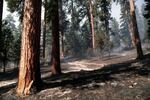
An aerial image shows the Ochoco National Forest on July 9, 1999.
U.S. Forest Service Pacific Northwest Region / Flickr
New federal guidelines allow cutting large trees that have been off-limits to logging for nearly three decades across 8 million acres of Eastern Oregon.
The U.S. Forest Service last week approved amendments to what’s known as the Eastside Screens, a plan to manage old-growth forests, rivers and streams, wildlife habitat, and more for six national forests east of the Cascades.
The amendments do away with the “21-inch rule,” which prohibited cutting trees larger than 21 inches in diameter and safeguarded many of the oldest trees.
Rob Klavins, Northeast field coordinator for the conservation group Oregon Wild, said axing the rule removes “the only real meaningful protections for old-growth forests in Eastern Oregon.”
“The logging lobby has been trying to kill old-growth protections for 25 years,” he said. “And the Trump administration just gave them what they wanted.”
The Forest Service made its decision in the name of wildfire preparedness. Decades of aggressive fire suppression has left many Northwest forests overgrown with hazardous fuel.
Ochoco National Forest supervisor Shane Jeffries said the 21-inch rule made it difficult to remove fire-prone species like grand fir and white fir without a lengthy regulatory process.
“We’re looking to create landscapes that withstand and recover more quickly from wildfire, drought and other disturbances,” Jeffries said. “We’re not looking to take every grand fir and white fir out of the forests.”
Environmental organizations have questioned the agency’s assertion that this decision is about building fire resistance and not about just cutting big trees.
Related: Trump administration slashes 3.4 million acres of critical habitat for spotted owl
In a month that also saw the slashing of 3.4 million acres of northern spotted owl habitat in old-growth forests west of the Cascades crest, the groups are framing changes to the Eastside Screens policy as nothing more than a wink and a wave to the timber industry from former President Donald Trump as he was leaving the White House.
Research indicates large trees capture and store disproportionate amounts of carbon, which helps combat climate change. (The Forest Service dismissed these studies as oversimplified in its final environmental assessment.)
The timber industry for decades logged old-growth, westside forests in the Northwest. A protracted fight over old trees and their right to exist led to greater forest protections on federal lands.
Related: How a fight over owls and trees became one of the biggest environmental conflicts of the century
The Clinton administration helped broker the Northwest Forest Plan for the western parts of Oregon, Washington and California. As coastal forest protections sent timber profits plunging, the industry sought more cutting east of the mountains. High Country News in 1994 described the dry side like the opposite end of a seesaw.
Enter: the Eastside Screens policy, which included protections for old-growth. The Screens were intended as a placeholder until a more holistic plan could be developed, but they’ve stuck around since before the turn of the last century.
Amendments to the Screens policy add guidelines that allow cutting grand fir and white fir up to 30 inches in diameter and other species up to 21 inches across. Unlike the previous rule, the guidelines are not outright prohibitions.
“I think a lot of folks are under the impression that a guideline is sort of optional, and the Forest Service doesn’t really have to follow it if we don’t feel like it,” said Emily Platt, special project coordinator with the Forest Service Portland regional field office, “but that’s not how guidelines work.”
The agency says its intention is to better prepare forests for wildfire in the short term and grow the number of old trees across the region in the long term.

A thinned ponderosa pine stand treated with prescribed fire in the Ochoco National Forest on Sept. 9, 1995.
Tom Iraci / Ochoco National Forest
If older trees are not increasing across the landscape or monitoring plans are not being followed, the plan directs the regional forester to implement stricter protections for trees at least 150 years old.
Research has called into question industry assertions that logging reduces wildfire risk and that thinning alone reduces fire intensity or severity.
Related: Despite what the logging industry says, cutting down trees isn't stopping catastrophic wildfires
Targeted reduction of brush, small trees and other ladder fuels — especially in close proximity to homes and businesses — can help prevent the catastrophic losses to wildfire like those in 2020.
“The idea that we have to log big and old trees to prevent wildfire, it’s just not accurate,” said Oregon Wild’s Klavins. “Agencies can make really good progress on all their purported restoration goals — whether that’s reducing ladder fuels, reducing density, thinning trees — by focusing on smaller trees.”
The Forest Service also faces scrutiny for how amendments to the Eastside Screens rule were approved.
The project website promised additional public involvement up until at least Wednesday, Jan. 13, according to an archived webpage. The agency then appeared to ditch plans to prepare a more-rigorous “environmental assessment” and instead issued an “environmental analysis,” which requires less public input. The amendments were approved and enacted on Jan. 15.
A group of 33 conservation organizations sent a letter to President Joe Biden’s transition team requesting they halt the amendments.




